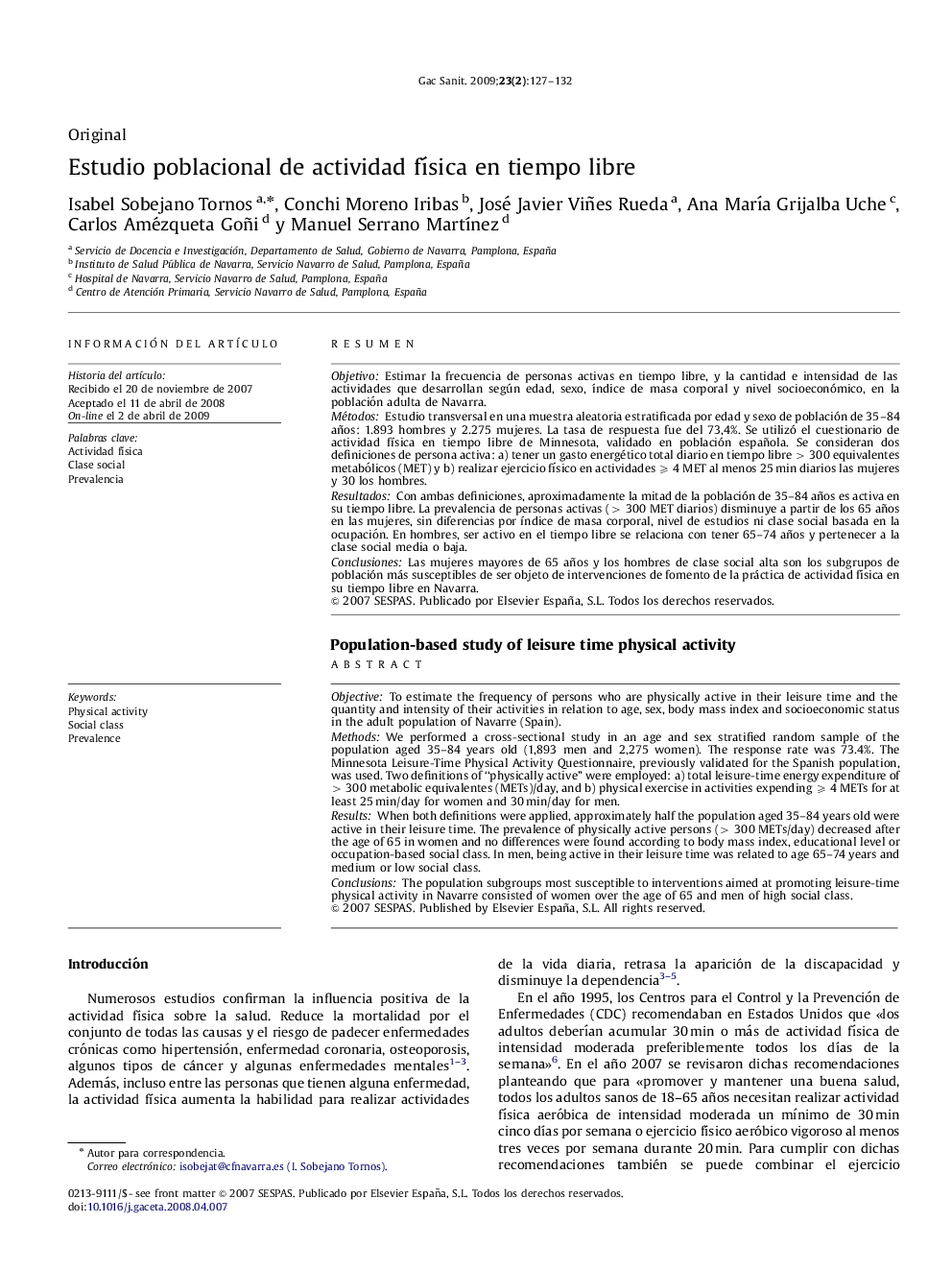| کد مقاله | کد نشریه | سال انتشار | مقاله انگلیسی | نسخه تمام متن |
|---|---|---|---|---|
| 1074503 | 949831 | 2009 | 6 صفحه PDF | دانلود رایگان |

ResumenObjetivoEstimar la frecuencia de personas activas en tiempo libre, y la cantidad e intensidad de las actividades que desarrollan según edad, sexo, índice de masa corporal y nivel socioeconómico, en la población adulta de Navarra.MétodosEstudio transversal en una muestra aleatoria estratificada por edad y sexo de población de 35–84 años: 1.893 hombres y 2.275 mujeres. La tasa de respuesta fue del 73,4%. Se utilizó el cuestionario de actividad física en tiempo libre de Minnesota, validado en población española. Se consideran dos definiciones de persona activa: a) tener un gasto energético total diario en tiempo libre > 300 equivalentes metabólicos (MET) y b) realizar ejercicio físico en actividades ⩾ 4 MET al menos 25 min diarios las mujeres y 30 los hombres.ResultadosCon ambas definiciones, aproximadamente la mitad de la población de 35–84 años es activa en su tiempo libre. La prevalencia de personas activas (> 300 MET diarios) disminuye a partir de los 65 años en las mujeres, sin diferencias por índice de masa corporal, nivel de estudios ni clase social basada en la ocupación. En hombres, ser activo en el tiempo libre se relaciona con tener 65–74 años y pertenecer a la clase social media o baja.ConclusionesLas mujeres mayores de 65 años y los hombres de clase social alta son los subgrupos de población más susceptibles de ser objeto de intervenciones de fomento de la práctica de actividad física en su tiempo libre en Navarra.
ObjectiveTo estimate the frequency of persons who are physically active in their leisure time and the quantity and intensity of their activities in relation to age, sex, body mass index and socioeconomic status in the adult population of Navarre (Spain).MethodsWe performed a cross-sectional study in an age and sex stratified random sample of the population aged 35–84 years old (1,893 men and 2,275 women). The response rate was 73.4%. The Minnesota Leisure-Time Physical Activity Questionnaire, previously validated for the Spanish population, was used. Two definitions of “physically active” were employed: a) total leisure-time energy expenditure of > 300 metabolic equivalentes (METs)/day, and b) physical exercise in activities expending ⩾ 4 METs for at least 25 min/day for women and 30 min/day for men.ResultsWhen both definitions were applied, approximately half the population aged 35–84 years old were active in their leisure time. The prevalence of physically active persons (> 300 METs/day) decreased after the age of 65 in women and no differences were found according to body mass index, educational level or occupation-based social class. In men, being active in their leisure time was related to age 65–74 years and medium or low social class.ConclusionsThe population subgroups most susceptible to interventions aimed at promoting leisure-time physical activity in Navarre consisted of women over the age of 65 and men of high social class.
Journal: Gaceta Sanitaria - Volume 23, Issue 2, March–April 2009, Pages 127–132